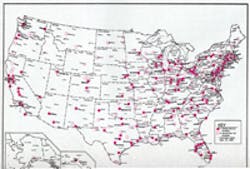Satellite Communications Were Expected To Fill Broad Cellular Gaps
Cellular devices and technologies are certainly prevalent in consumers' daily lives. Families now have multiple cell phones in addition to other wireless communications devices like tablets. Indeed, the cellular phone is slowly making standard house phones obsolete. To support all of these devices, cellular coverage almost completely blankets the US mapwith the exception of some rural areas. In 1987, however, it did not appear that cellular coverage would be quite so widespread (see figure).
The lead News article in the December 1987 issue of this magazine heralded this fact: "All 305 designed metropolitan service areas in the US are expected to have service by 1990, and the Federal Communications Commission (FCC) has begun licensing operators for 423 rural service areas. Twenty-two major Canadian cities also feature cellular service." The writer of the article is suitably impressed by this progress. After all, though it pales in comparison to what is available today, these first cellular services were literally built from nothing.
Interestingly, the article also is excessivelyand very unrealisticallyoptimistic about broader coverage and when it would be available: "Even when all the cellular systems are completed, mobile telecommunication services will not be available in sparsely populated areas located far from major cities and towns. Mobile satellite service (MSS), now under development in the US and Canada, will fill these gaps. Once mobile satellites are launched, probably in the early 1990s, voice and data communications will be available nearly everywhere in the two countries."
Theoretically, we can say that such services were potentially available on that timelineif you were able to pay a hefty fee for satellite phone service. NASA had demonstrated the feasibility of communication between satellites and mobile units about a decade before, according to the article. In fact, it was at NASA's urging that the US delegation to the 1979 World Administrative Radio Conference (WARC) was granted a frequency allocation in the 806-to-890-MHz range for mobile satellite service (MSS) in Region 2. That region included North and South America.
In late 1982, NASA petitioned the FCC to allocate 20 MHz for MSS in the 806-to-890-MHz range. The next year, before the FCC responded to NASA's request, Mobile Satellite Corp. and Skylink Corp. applied for developmental MSS licenses. In 1985, the FCC issued a notice proposing that specific frequencies in the 806-to-890-MHz range be allocated for MSS. In addition, a segment of the L-band around 1.5 GHz would be available to carry MSS traffic that could not be accommodated at lower frequencies.
And the race was on, with 12 companies that were interested in providing MSS filing by the FCC-designated deadline. The future took shape as lobbyists debated the advantages and disadvantages of different bands and frequency allocations. Sensing opportunity, many companies (some short-lived) entered the satellite market picture. The wireless communications scene was much as it is todayfilled with debate, controversy, opinions, and colorful characters. It seems that the birth of cellular and satellite communications pretty much set the tone for the politics of communications going forward.
About the Author

Nancy Friedrich
RF Product Marketing Manager for Aerospace Defense, Keysight Technologies
Nancy Friedrich is RF Product Marketing Manager for Aerospace Defense at Keysight Technologies. Nancy Friedrich started a career in engineering media about two decades ago with a stint editing copy and writing news for Electronic Design. A few years later, she began writing full time as technology editor at Wireless Systems Design. In 2005, Nancy was named editor-in-chief of Microwaves & RF, a position she held (along with other positions as group content head) until 2018. Nancy then moved to a position at UBM, where she was editor-in-chief of Design News and content director for tradeshows including DesignCon, ESC, and the Smart Manufacturing shows.
